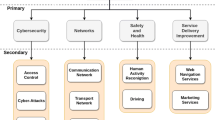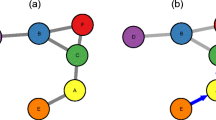Abstract
Link prediction is the problem of inferring new relationships among nodes in a network that are likely to occur in the near future. Classical approaches mainly consider neighborhood structure similarity when linking nodes. However, we may also want to take into account if the two nodes are already indirectly interacting and if they will benefit from the link by having an active interaction over the time. For instance, it is better to link two nodes u and v if we know that these two nodes will interact in the social network even in the future, rather than suggesting \(v'\), which will never interact with u. In this paper, we deal with a variant of the link prediction problem: Given a pair of indirectly interacting nodes, predict whether or not they will form a link in the future. We propose a solution to this problem that leverages the predicted duration of their interaction and propose two supervised learning approaches to predict how long will two nodes interact in a network. Given a set of network-based predictors, the basic approach consists of learning a binary classifier to predict whether or not an observed indirect interaction will last in the future. The second and more fine-grained approach consists of estimating how long the interaction will last by modeling the problem via survival analysis or as a regression task. Once the duration is estimated, new links are predicted according to their descending order. Experimental results on Facebook Network and Wall Interaction and Wikipedia Clickstream datasets show that our more fine-grained approach performs the best and beats a link prediction model that does not consider the interaction duration and is based only on network properties.


Similar content being viewed by others
Notes
For the case of classification, we considered the predicted probability of having a link in the future.
References
Adafre SF, de Rijke M (2005) Discovering missing links in Wikipedia. In: LinkKDD ’05, pp 90–97
Ameri S, Fard MJ, Chinnam RB, Reddy CK (2016) Survival analysis based framework for early prediction of student dropouts. In: CIKM, pp 903–912
Backstrom L, Leskovec J (2011) Supervised random walks: predicting and recommending links in social networks. In: WSDM, pp 635–644
Brin S, Page L (1998) The anatomy of a large-scale hypertextual web search engine. Comput Netw 30(1–7):107–117
Cacheda F, Barbieri N, Blanco R (2017) Click through rate prediction for local search results. In: WSDM, pp 171–180
Dave VS, Hasan MA, Reddy CK (2017) How fast will you get a response? Predicting interval time for reciprocal link creation. In: ICWSM, pp 508–511
Davis J, Goadrich M (2006) The relationship between precision-recall and roc curves. In: Proceedings of the 23rd international conference on machine learning. ACM, pp 233–240
Dhakal N, Spezzano F, Xu D (2017) Predicting friendship strength for privacy preserving: a case study on Facebook. In: ASONAM, pp 1096–1103
Gilbert E, Karahalios K (2009) Predicting tie strength with social media. In: CHI, pp 211–220
Goyal P, Ferrara E (2018) Graph embedding techniques, applications, and performance: a survey. Knowledge-Based Syst 151:78–94
Grover A, Leskovec J (2016) Node2vec: scalable feature learning for networks. In: KDD, pp 855–864
Gundala LA, Spezzano F (2018) A framework for predicting links between indirectly interacting nodes. In: IEEE/ACM 2018 international conference on advances in social networks analysis and mining, ASONAM 2018, Barcelona, Spain, August 28–31, 2018, pp 544–551
Hasan MA, Zaki MJ (2011) A survey of link prediction in social networks. In: Aggarwal C (ed) Social network data analytics. Springer, Boston, MA, pp 243–275
Jones JJ, Settle JE, Bond RM, Fariss CJ, Marlow C, Fowler JH (2013) Inferring tie strength from online directed behavior. PloS One 8(1):e52168
Kahanda I, Neville J (2009) Using transactional information to predict link strength in online social networks. In: 3rd international AAAI conference on weblogs and social media, pp 74–81
Kamath K, Sharma A, Wang D, Yin Z (2014) Realgraph: user interaction prediction at twitter. In: User Engagement Optimization Workshop @ KDD
Kumar S, Spezzano F, Subrahmanian VS, Faloutsos C (2016) Edge weight prediction in weighted signed networks. In: ICDM, pp 221–230
Lei C, Ruan J (2012) A novel link prediction algorithm for reconstructing protein–protein interaction networks by topological similarity. Bioinformatics 29(3):355–364
Liben-Nowell D, Kleinberg J (2007) The link-prediction problem for social networks. J Assoc Inf Sci Technol 58(7):1019–1031
Li Y, Rakesh V, Reddy CK (2016) Project success prediction in crowdfunding environments. In: WSDM, pp 247–256
Menon AK, Elkan C (2011) Link prediction via matrix factorization. In: ECML PKDD, pp 437–452
Murtaugh PA, Burns LD, Schuster J (1999) Predictiong the retention of university students. Res High Educ 40(3):355–371
Noraset T, Bhagavatula C, Downey D (2014) Adding high-precision links to Wikipedia. In: EMNLP ’14, pp 651–656
Paranjape A, West R, Zia L, Leskovec J (2016) Improving website hyperlink structure using server logs. In: WSDM ’16, pp 615–624
Pavlov M, Ichise R (2007) Finding experts by link prediction in co-authorship networks. In: Proceedings of the 2nd international conference on finding experts on the web with semantics, vol 290, pp 42–55
Pavlov M, Ichise R (2007) Finding experts by link prediction in co-authorship networks. In: Proceedings of the 2nd international conference on finding experts on the web with semantics, vol 290. FEWS’07, pp 42–55
Perozzi B, Al-Rfou R, Skiena S (2014) Deepwalk: online learning of social representations. In: KDD, pp 701–710
Qian Y, Adali S (2014) Foundations of trust and distrust in networks: extended structural balance theory. ACM Trans Web (TWEB) 8(3):13
Rakesh V, Lee W, Reddy CK (2016) Probabilistic group recommendation model for crowd funding domains. In: WSDM, pp 257–266
Richardson M, Dominowska E, Ragno R (2007) Predicting clicks: estimating the click-through rate for new ads. In: WWW, pp 521–530
Tang L, Liu H (2011) Leveraging social media networks for classification. Data Min Knowl Discov 23(3):447–478
Tang J, Qu M, Wang M, Zhang M, Yan J, Mei Q (2015) Line: large-scale information network embedding. In: WWW, pp 1067–1077
Viswanath B, Mislove A, Cha M, Gummadi KP (2009) On the evolution of user interaction in Facebook. In: WOSN, pp 37–42
Wang P, Li Y, Reddy CK (2017) Machine learning for survival analysis: a survey. CoRR arXiv:abs/1708.04649
West R, Paranjape A, Leskovec J (2015) Mining missing hyperlinks from human navigation traces: a case study of Wikipedia. In: WWW ’15, pp 1242–1252
West R, Paskov HS, Leskovec J, Potts C (2014) Exploiting social network structure for person-to-person sentiment analysis. Trans Assoc Comput Linguist 2:297–310
West R, Pineau J, Precup D (2009) Wikispeedia: an online game for inferring semantic distances between concepts. In: IJCAI’09, pp 1598–1603
West R, Precup D, Pineau J (2009) Completing Wikipedia’s hyperlink structure through dimensionality reduction. In: CIKM ’09, pp 1097–1106
Wilson C, Sala A, Puttaswamy KP, Zhao BY (2012) Beyond social graphs: user interactions in online social networks and their implications. ACM Trans Web (TWEB) 6(4):17
Xiang R, Neville J, Rogati M (2010) Modeling relationship strength in online social networks. In: WWW, pp 981–990
Zignani M, Gaito S, Rossi GP (2016) Predicting the link strength of “newborn” links. In: WWW Companion, pp 147–148
Author information
Authors and Affiliations
Corresponding author
Additional information
This paper is an extended version of the conference paper “Laxmi Amulya Gundala and Francesca Spezzano, A Framework for Predicting Links Between Indirectly Interacting Nodes. In Proceedings of the IEEE/ACM 2018 International Conference on Advances in Social Networks Analysis and Mining (ASONAM 2018), pp 544–551” (Gundala and Spezzano 2018).
Rights and permissions
About this article
Cite this article
Gundala, L.A., Spezzano, F. Estimating node indirect interaction duration to enhance link prediction. Soc. Netw. Anal. Min. 9, 17 (2019). https://doi.org/10.1007/s13278-019-0561-2
Received:
Revised:
Accepted:
Published:
DOI: https://doi.org/10.1007/s13278-019-0561-2




